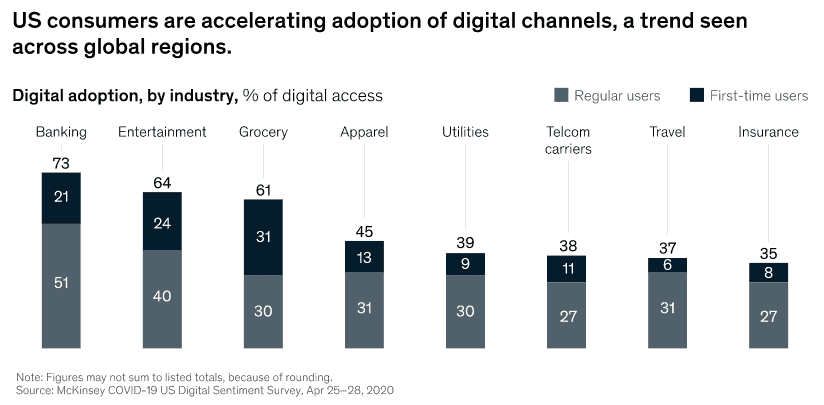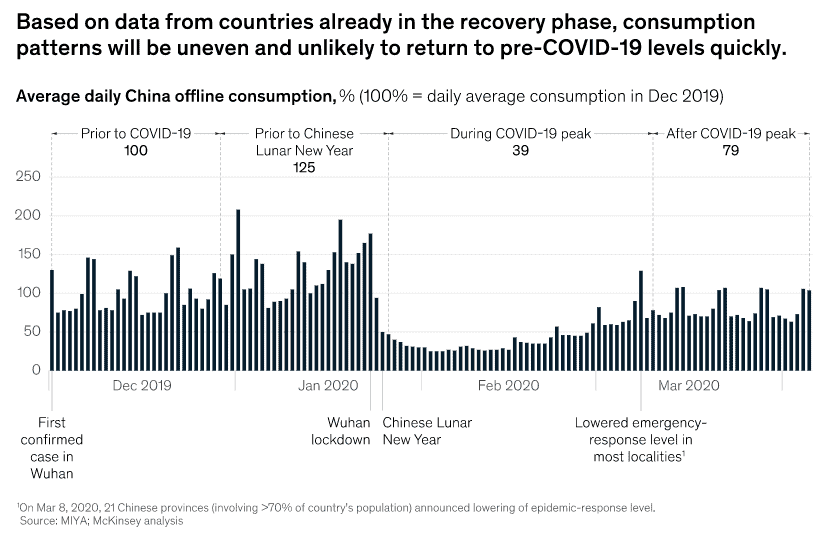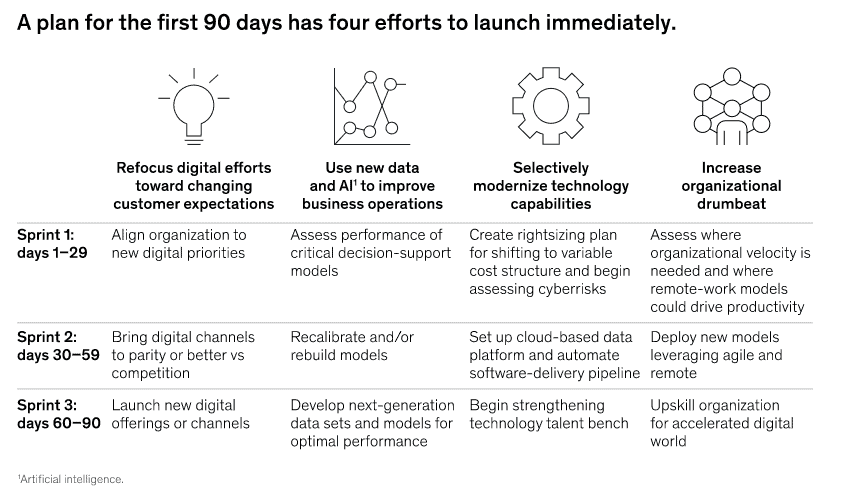The rapid migration to digital technologies driven by the pandemic will continue to recover. See how to accelerate your organization's digital capabilities to keep pace with growth or even decline in revenue using Digital Transformation.
Per Aamer Baig, Bryce Hall, Paul Jenkins, Eric Lamarre, and Brian McCarth of Mckinsey, April 14, 2020.
So far, most C-level executives have led their companies to digitize at least part of their business to protect employees and serve customers facing mobility restrictions as a result of the COVID-19 crisis. As a CEO of a large information technology company recently stated:
"We are witnessing what will surely be remembered as a historic rollout of teleworking and digital access to services across all domains, digital transformation will be a key part of COVID-19's recovery"
Indeed, recent data show that we've advanced five years in consumer and business digital adoption in a matter of about eight weeks, showing the sense of urgency of digital transformation.
Banks have transitioned to remote sales and service teams and launched digital outreach to customers to make flexible payments for loans and financing. Supermarkets have moved to online ordering and delivery as their core business. Schools in many locations have pivoted to 100% of online learning and digital classrooms.
Doctors began to use telemedicine, aided by more flexible regulation. Manufacturers are actively developing plans for factories and supply chains to “turn out the lights”. The list goes on… impacting business strategies.
As some regions begin to reopen, setting clear rules for social distancing, companies are considering how to return at full speed in an unstable environment with a return in waves. In doing so, they will have to face three structural changes that are taking place.
First of all, customer behaviors and preferred interactions have changed significantly with social isolation, and while they will continue to change, the rise in the use of digital services is here to stay, at least to some extent (Figure 1). 75% of people using digital channels for the first time indicate that they will continue to use them when things get back to "normal".
Companies will need to ensure that their digital channels are on par with or better than their competition to succeed in this new environment. If China offers us any lessons: Digital laggards will be substantially disadvantaged during the recovery.

In second place, as the economy retreats, demand recovery will be unpredictable; uneven across geographies, industries, product categories and customer segments; and they are often slow to return to pre-crisis levels. While some industries face extraordinarily strong demand, leaders in many industries must deal with periods of structural overcapacity.
These companies face the painful need to correct the cost base and capital of their operations, supply chains and organizations in general, and to transition their fixed costs to variable costs aggressively whenever possible. Things get tricky for leaders as they grapple with ways to tackle a patchy recovery is that historical data and forecasting models will be of little use in predicting where pockets of demand will emerge and where supply will be needed.
New data and completely reconstructed analytical models will be essential to guide operational decisions.
Finally, many organizations switched to teleworking models almost overnight. A remote setup allows companies to mobilize global expertise instantly, organize a 20- or 200-person design review immediately, and respond to customer questions faster, providing everything from product information to sales and after-sales support digitally.
In fact, remote ways of working have, at least in part, driven the faster execution we're all experiencing in our organizations. And this step change in remote adoption is now arguably substantial enough to reconsider current business models.
Quickly pivoting the business agenda to deal with these changes will be critical to a successful turnaround. The digital will undoubtedly play a central role. Below are suggestions for a 90-day plan to realign the digital agenda and implement facilitators for acceleration through recovery and beyond.
The Digital Agenda for Recovery
For many companies, customers have already moved to digital. Employees are already working nearly 100% remotely and are agile to some extent. Companies need to launch analytics and artificial intelligence (AI) initiatives into their operations.
Information Technology teams have already delivered at a pace they never had before. But for most companies, changes to the date represent only the first phase of the changes that will be needed.
We've set an agenda that focuses on four efforts: reorienting and accelerating digital investments in response to evolving customer needs, using new data and AI to improve business operations, selectively modernizing technology capabilities to speed development and increase the organizational agility to deliver faster. For each, we have a practical 90-day plan to make this happen (Figure 2).

1- Focus digital efforts to change customer expectations and make the Digital Transformation
Many companies are accelerating their shift towards the business model Digital First — at accelerated speed. A European chain of retail stores, for example, set up a fully functioning e-commerce business in just three months.
The online shopping business was interconnected across all functions (storage, merchandising, marketing, customer support, etc.) and improved the average ticket over physical stores by three times, in addition to providing a growth of almost 31TP1Q of similar revenue in its main market.
But it's not just about scanning. Companies must also re-imagine customer journeys to reduce friction, accelerate the move to digital channels, and deliver new information security and data protection requirements.
For example, an automaker now handles roles traditionally performed by dealers, such as trade-ins, financing, maintenance, and home delivery of cars.
Airlines are rapidly reinventing the passenger experience with contactless travel focused on the health and safety of travelers to make customers feel comfortable about flying again (Figure 3).

in the next 90 days. CEOs should ask their business leaders to assess how their most important customers' needs and behaviors have changed with Covid-19 and to benchmark their digital channels against those of their competition. This information should form the basis of a renewed digital agenda that shouldn't take more than 30 days to establish.
Digital directors and directors of information technology (CIOs) can then quickly change (or refocus) agile teams to execute the most pressing priorities. One consumer electronics company, for example, recently launched an agile war room to improve conversion rates on its website traffic. This type of project can deliver significant results in weeks.
Changes that require more fundamental work, such as creating a new e-commerce channel, will typically take longer. Continuously measuring the performance of digital channels over the 90 days will be critical for companies to quickly adapt as they learn more.
Consider creating a weekly forum for senior business and technology leaders to process incoming learning and drive the entire agenda in a coordinated, paced fashion.
2- Use new analytics and artificial intelligence to improve business operations
Hundreds of operational decisions are made on a daily, weekly and monthly basis. Take an airline, for example, that must make many decisions: Which routes should we operate? How large is the crew for each flight? How many meals should we order? What level of staff is needed in the call center?
Modern companies have several forecasting and planning models to guide such operational decisions. Organizations will need to validate these models. Just as many companies had to rebuild risk and financial models that failed during the 2008 financial meltdown, the models will also need to be replaced due to the huge economic and structural changes caused by the pandemic.
For example, models that use weather forecast, historical weather, oil price or unemployment data will need to be completely rebuilt. The data must also be re-evaluated.
As companies build these models, analytics teams will likely need to gather new datasets and use improved modeling techniques to successfully forecast demand and manage assets. One automotive parts supplier, for example, developed a prediction model that incorporated previously unused third-party data.
The template will help the supplier to detect potential issues with their own suppliers' ability to deliver needed items, offering the chance to reach out to their suppliers to work on logistics or find another source.
Other business areas can also benefit from more sophisticated models. One of the leading financial services providers, for example, has come up with an AI-powered solution to generate leads for its sales agents, with models calibrated to handle today's environment.
In the next 90 days. As a first step, the director of analytics and data (or equivalent) should mobilize an effort to inventory core business models that support business operations and work with business leaders to prioritize them based on their impact on key operations.
This assessment is urgent and must be completed as soon as possible. It will essentially define a quick-fix program that the data and analytics team can undertake, working side-by-side with business and functional leaders.
Once the situation stabilizes, CEOs and business leaders must put pressure on their data and analytics teams to develop next-generation models that leverage new datasets and modeling techniques better suited to rapidly changing environments.
More advanced companies are already creating synthetic datasets using advanced machine learning techniques such as generative adversarial networks (GANs) to train new analytical models when historical data is of little use.
3- Selectively modernize technological capabilities for the digital transformation
Successfully executing the described agenda requires investment capacity and speed of development. CIOs can both contribute to supporting the IT cost structure for new levels of demand and reinvesting freed resources in customer-facing digital solutions and critical decision support systems in the first place.
Companies can also devote part of the savings to selective modernization of the area of infrastructure technology and software development tools.
Many companies have found they have the potential to release up to 45% of their IT costs over the course of a year. Our experience suggests that around two-thirds of this potential can be achieved through measures such as extending hardware and software upgrade cycles, quickly renegotiating vendor contracts, and cloud workload restriction, shutting down non-critical jobs.
Additional cuts deepen the cost structure and risk hampering future growth. The right balance will vary by industry, but in either scenario, rightsizing must expose the investment capacity needed as soon as possible to fund the 90-day plan.
As CIOs consider updating their technology areas, two characteristics of a modern technology environment are particularly important and can be quickly implemented: a data platform based on a cloud and an automated software delivery pipeline (commonly referred to as “continuous integration and continuous delivery”).
Without it, development speed stops and gets bogged down in complexity. The good news is that cloud technologies make it possible to deploy them quickly and at a relatively low cost.
in the next 90 days. First, develop the plan to correct and create a more variable cost structure — the faster the better free up resources for the digital agenda.
In the second 30-day sprint, choose your cloud partners. While speed is critical, CIOs should carefully consider the contractual structures offered by technology providers. Carefully review those that look too good to pass to ensure providers aren't capturing all the value.
And remember to launch appropriate internal efforts to train and prepare teams to operate in the new environment.
During this sprint, it's also time to selectively modernize the technology infrastructure — “selectively” being the operational word. Most companies will not have the management bandwidth and resources to undertake large-scale modernization for the next 12 to 18 months.
By focusing on configuring or improving a cloud-based data platform and equipping agile teams with automated software delivery, CIOs can double or even triple the speed of development in the short term.
In the final sprint, it's easy to launch additional digital talent recruitment and accelerate the digital qualification of the entire organization. These steps will well prepare organizations for a more substantive modernization of their application landscapes after recovery.
Finally, continue to pay attention to digital and cybersecurity. Much of the rapid IT work undertaken during the COVID-19 crisis may have created cybersecurity or digital security risk exposures.
4 – Increase organizational pace and speed
The current crisis has forced organizations to adapt quickly to new realities, opening everyone's eyes to new, faster ways of working with customers, suppliers and colleagues. Many CEOs wonder what it will take to keep the organizational drumbeat accelerating.
Companies that have led the adoption of faster, more fully agile organizational models have shown substantial improvements in both execution pace and productivity.
This remained true during the crisis, as we see a direct correlation between agile pre-crisis maturity and the time it took companies to launch a first crisis-related product or service.
While many companies have at least a few agile teams in place, few have managed to scale to hundreds of teams with far more “executors” than “checkers,” which is what's needed to drive the accelerated organizational pace that the crisis — and even the next normal — demands.
What can realistically be done in 90 days to increase organizational speed? Building a digital factory is largely the best approach now because it can be built and scaled in three months or less. Many organizations, from banks to mining companies, have accelerated and scaled their digital delivery by establishing these in-house factories, with interdisciplinary teams aligned with companies' digital priorities.
A major global bank, for example, has built five such factories to support various locations in the Americas.
As mentioned earlier, teleworking can also help organizations move at a faster pace as companies explore new pools of work and specialized remote experiences. (And yes, agile can be run remotely.)
Remote working can also open up new productivity opportunities, especially for companies with large field strengths. One of the leading residential solar service providers recently documented record sales using a more remote sales model.
Telecommuting can help organizations move at a faster pace as companies explore new pools of work and specialized symmetric experience. (And yes, agile can be run remotely.)
in the next 90 days. During the first sprint, identify areas of the business where speed of digital execution is required and map plans for digital factories to support them. In parallel, assess where teleworking models could trigger productivity benefits.
These two lenses should define the table for changes directed to the operating model. In the second 30-day sprint, design the new models with consideration for staffing level, experience mix, governance, and operating procedures. Finally, in the third month, implement and operationalize the new projects.
We know from experience that three months is enough to implement and scale a digital factory. We've also seen banks, pharmaceutical companies and insurance companies turn entire field forces to a remote model in a few weeks.
Leaders who want to succeed in digital-led recovery must quickly redefine their digital agendas to meet changing customer needs, strengthen their decision support systems, and adjust their organizational models and technology areas to operate at the highest effective speed.
In other words, C-level executives must aim their digital firepower at the right targets and quickly execute against them. It's essential to set these goals early and regularly measure progress against them.
Achieving parity or better across digital channels to win the revenue race, rebuilding the most critical decision support models, and doubling development speed are all goals that are within reach. The 90-day plan will help organizations get there.
About the Authors: Aamer Baig is a senior partner in McKinsey's Chicago office; Bryce Hall is a partner in the Washington, DC office; Paul Jenkins he is a senior partner at the Oslo office; Eric Lamarre is a senior partner in the Boston office; and Brian McCarthy is a partner in the Atlanta office.
Translated by 4Matt Technology from McKinsey's original: The COVID-19 recovery will be digital: A plan for the first 90 days
Tag: code of conduct, digital transformation in the world, digital transformation in times of Covid-19, business model in Covid-19. Talk to us through social networks and receive news new technologies digital transformation in companies cloud computing customer experience collect data what your impacts importance of digital transformation digital transformation strategy digital transformation goal leave a comment digital world competitive advantages social media it sector use of technology digital environment company starts talk to our consultants free materials digital accessibility company management sustainable development useful links focus on the customer digital transformation impacts decision-making digital strategy customer service constant changes improve practically new solutions impacts of digital transformation impacts on society experience user guide complete transformation process digital maturity pillars of digital transformation rock content digital government brazilian strategy challenges of digital transformation pillar of transformation digital transformation trends digital transformation process mobile devices personal data positive impacts cultural change worth investing action plans key technologies business processes electronic signature technological advancement virtual reality history of digital transformation new opportunities organization needs technology company social media contact us digital technologies Transformation Digital McKinsey Digital ServiceNow Software Asset Management Software Asset Management
